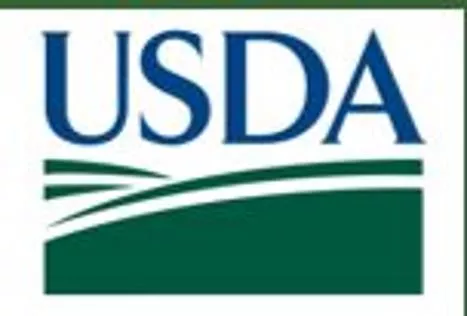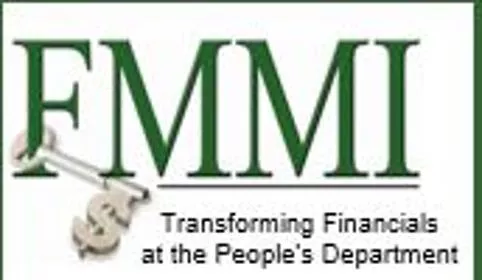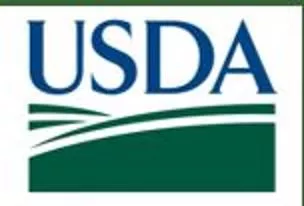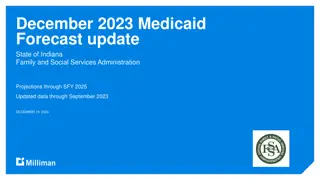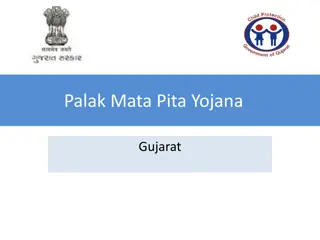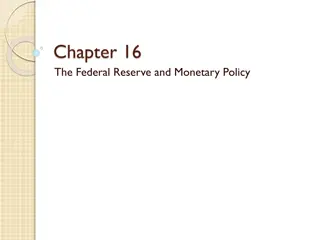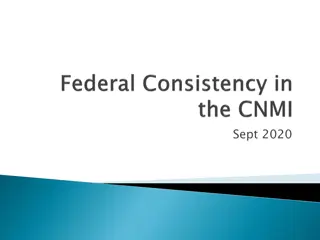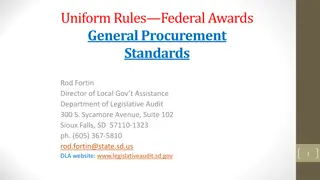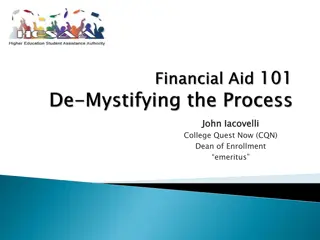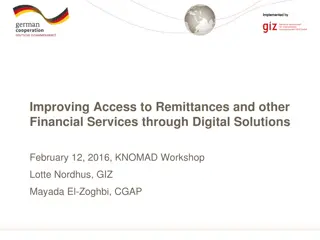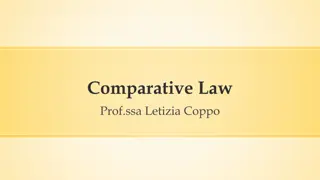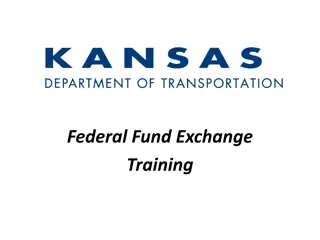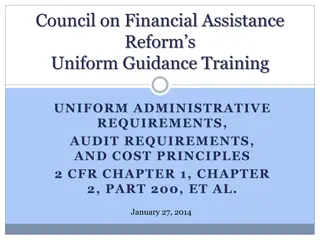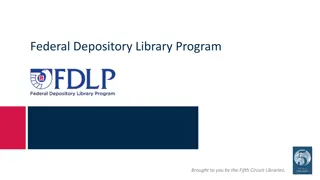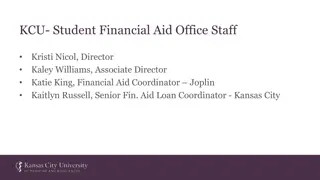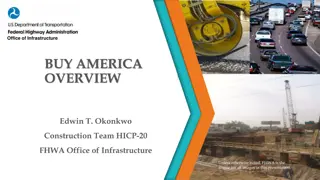Federal Financial Assistance Update - May 2018
This update covers the history, fundamentals, stakeholders, and acronyms related to federal financial assistance in the United States. It discusses major developments in federal assistance over the years and highlights key stakeholders involved in the process.
Download Presentation

Please find below an Image/Link to download the presentation.
The content on the website is provided AS IS for your information and personal use only. It may not be sold, licensed, or shared on other websites without obtaining consent from the author.If you encounter any issues during the download, it is possible that the publisher has removed the file from their server.
You are allowed to download the files provided on this website for personal or commercial use, subject to the condition that they are used lawfully. All files are the property of their respective owners.
The content on the website is provided AS IS for your information and personal use only. It may not be sold, licensed, or shared on other websites without obtaining consent from the author.
E N D
Presentation Transcript
Federal Financial Assistance Update May 2018
Agenda This presentation includes the following five sections: A. Introduction B. Fundamentals C. Detailed Process D. Terms and Conditions E. Additional Resources 2
Acronyms The following acronyms are used in this presentation: CFDA Catalog of Federal Domestic Assistance CFR Code of Federal Regulations DUNS Data Universal Number System FAR Federal Acquisition Regulations FOIA Freedom of Information Act OMB Office of Management and Budget SF Standard Form USC United States Code 3
Fundamentals May 2018
History of Federal Financial Assistance Federal assistance has increased in volume, type, and complexity over time. Major developments are presented below. Year(s) Development 1800s Federal assistance began with land grants to states for schools, public buildings, and railroads 1880s Assistance expanded with cash grants for agricultural research 1930s Works Progress Administration provided jobs for unemployed during the Great Depression 1950s National Science Foundation began funding research 1960s Great Society legislation included cash grants for educational materials and programs and loans and grants for rural development 1972 With a variety of assistance instruments among Federal agencies, the Commission on Government Procurement recommended legislation to clarify the difference between procurement and assistance, and instrument types within assistance 1978 Federal Grant and Cooperative Agreement Act defined three instruments (grants, cooperative agreements, and contracts) 1999 2007 Office of Management and Budget (OMB) and major grant-making agencies standardized several elements of grant application and administration 2013 2014 OMB and major grant-making agencies standardized additional elements of grant administrative requirements, cost principles, and audit requirements 5
Federal Financial Assistance Stakeholders The following groups are involved in Federal financial assistance at various levels (not all stakeholders are required for each award): Stakeholder Role Congress Provides program authorization; appropriates funds for activities deemed deserving of stimulation and support from the Federal government Office of Management and Budget Coordinates development of US government-wide Federal financial assistance administration policies; issues guidance to agencies as needed Federal agencies Award and administer grant funds; act as cognizant agencies responsible for indirect cost rate negotiation and audit oversight Applicants, pass- through entities, non- Federal entities Compete for funds, propose projects and sometimes administer funded projects Beneficiaries Those in the general public who benefit from grant programs Taxpayers Ultimate funders of most grant programs 6
Award Instrument Types Award Type Description Grant agreement Transfers money, property, services, or anything of value to a recipient in order to accomplish a public purpose of support1without substantial involvement2 anticipated between the Federal agency and the non-Federal entity 41 USC 504(5)3 Cooperative agreement Transfers money, property, services, or anything of value to a recipient in order to accomplish a public purpose of support with substantial involvement anticipated between the Federal agency and the non-Federal entity 41 USC 504(6) Joint venture agreement Provides money, in-kind services, or property in lieu of money, to an eligible cooperator, or to the agency (from the cooperator) with the agreement objectives serving a mutual interest of the parties in agricultural research, extension,4 or teaching activities 7 USC 3318(b) Cost reimbursable agreement Procures goods and/or services to carry out agricultural research and teaching activities from authorized cooperators without the requirement to follow the Federal Acquisition Regulations 7 USC 3319a 1 In contrast, Federal procurement contracts acquires, by purchase, lease, or barter, property or services for the direct benefit or use of the Federal agency. Agencies have the authority through 41 USC 504(7) and 41 USC 503(4) to enter into contracts. 2 Substantial involvement includes assisting, guiding, coordinating, or participating in project activities. 3 That is, United States Code title 41, section 503, sub-section 4. 4 The term extension means the informal education programs conducted in the States in cooperation with the Department of Agriculture. 7 USC 3103(8). 7
Examples of Specific Authorizations Many Federal agencies are authorized to use grant agreements and cooperative agreements, while only USDA has the authority to use joint venture agreements and cost reimbursable agreements as defined below, as well as many others. Award Type Authorization Grant agreement Each agency must have both an authorization and appropriation to issue an award. For example, FAS has 7 USC 3291(a), which allows grants and cooperative agreements for international agricultural research extension and training activities. Cooperative agreement Each agency must have both an authorization and appropriation to issue a Federal award. For example, FAS has 7 USC 3291(a), which allows grants and cooperative agreements for international agricultural research extension and training activities. Joint venture agreement USDA has specific authorization through 7 USC 3318(b) to use a joint venture agreement if the agreement serves a mutual interest and both parties contribute resources to accomplishment of those objectives. Cost reimbursable agreement USDA has specific authorization through 7 USC 3319a to carry out cost-reimbursable agreements with state cooperative institutions or other colleges or universities. 8
Detailed Process May 2018
Federal Financial Assistance from Authorization to Closeout Congress creates program through authorization President requests funds. Congress appropriates funds Federal agency develops regulations/guidelines Congress creates program through authorization President requests funds. Congress appropriates funds Federal agency develops regulations/guidelines Agency reviews application and selects proposal Prospective non-Federal entity apply Federal agency advertises funds availability Agency reviews application and selects proposal Federal agency advertises funds availability Prospective non- Federal entity apply Non-Federal entity conducts project. Agency monitors award Award closes out Agency closes out program Non-Federal entity conducts project. Agency monitors award Agency closes out program Award closes out 10
Authorization (1 of 3) Authorization statutes, in which Congress grants authority to a Federal agency to create a Federal financial assistance program, include the following two types: Permanent authorizations - For programs with ongoing broad applicability - Example: the School Breakfast Program, administered by USDA Food and Nutrition Service. Time-limited authorizations - For programs serving specialized purposes or interest groups - Example: the McGovern Dole International Food for Education and Child Nutrition Program, administered by USDA Foreign Agriculture Service. 11 Program Regula-tions Funds Advertise-ment Application for Assistance Application Review Selection Implement-ation Monitoring Appropri-ation Award Closeout Program Closeout Program Regula- tions Funds Advertise- ment Application for Assistance Application Review & Selection Implement -ation & Monitoring Appropri- ation Award Closeout Program Closeout Authorization
Common Authorization Statute Elements (2 of 3) Element Description Short, descriptive title of a statute; may have two meaningful titles if an act within an act (e.g., Title X of the Community Services Act is also called the Legal Services Corporation Act) Title Goals and challenges to be addressed by the Federal assistance (i.e., the activities deemed deserving of stimulation and support from the Federal government) Statement of findings and purpose Precise definitions of terms used in the statute Definitions The executive branch agency to administer the program; Federal assistance instrument(s) to be used; guidance on levels of discretion given to the agency (e.g., distinguishing between whether assistance may or must be given) Authorization of assistance Required non-Federal entity attributes (e.g., only local governments are eligible to receive assistance) Eligibility Instructions on how to disburse funds (e.g., a maximum amount to be given to each non-Federal entity); specification if the statute creates a discretionary assistance program (i.e., the agency administering the assistance program has discretion over whether to make a grant to an applicant and how much to award) Funding directions Additional requirements for recipients of assistance (i.e., non-Federal entities are required to match a certain percentage of assistance with non-Federal funds) Conditions of aid 12 Program Regula-tions Funds Advertise-ment Application for Assistance Application Review Selection Implement-ation Monitoring Appropri-ation Award Closeout Program Closeout Program Regula- tions Funds Advertise- ment Application for Assistance Application Review & Selection Implement -ation & Monitoring Appropri- ation Award Closeout Program Closeout Authorization
Common Authorization Statute Elements (3 of 3) Element Description Prohibitions of discrimination based on factors such as race, sex, handicap, age, and religion Nondiscrimination Descriptions of audit and record-keeping requirements Fiscal accountability Consequences for noncompliance; incentives for exceeding minimum audit requirements Fiscal sanctions Description of power given to the executive branch agency administering the assistance program to develop rules to administer the program Rulemaking power Instructions for an aggrieved non-Federal entity to seek recourse for perceived ill-treatment by the executive branch agency administering the assistance program Administrative and judicial review Information and date due to be delivered to Congress by the executive branch agency administering the assistance program Required reporting Suggested funding levels to be included in subsequent appropriations legislation Authorization of appropriations 13 Program Regula-tions Funds Advertise-ment Application for Assistance Application Review Selection Implement-ation Monitoring Appropri-ation Award Closeout Program Closeout Program Regula- tions Funds Advertise- ment Application for Assistance Application Review & Selection Implement -ation & Monitoring Appropri- ation Award Closeout Program Closeout Authorization
Appropriation ( 1 of 2) Federal Financial assistance program funds are funded through a discretionary budget or appropriated. Appropriation OMB supervises creating the executive branch s proposed Federal budget. The President delivers the proposed budget to Congress, including funds for Federal assistance programs. Second, Congress appropriates funds for Federal assistance programs, through the annual fiscal budget or permanent funding statutes. Appropriation through annual fiscal budgets may be designated for one- year, two-year, or no-year (i.e., no time-based restrictions) use. Funding levels may change by year with different budget availability and priorities. Funds appropriated through permanent funding statutes are more predictable, as funding levels require a legislative update to be changed. 14 Program Regula-tions Funds Advertise-ment Application for Assistance Application Review Selection Implement-ation Monitoring Authorization Award Closeout Program Closeout Program Regula- tions Funds Advertise- ment Application for Assistance Application Review & Selection Implement -ation & Monitoring Award Closeout Program Closeout Appropri- ation Authorization
Apportionment and Allotment (2 of 2) Following funds appropriation, OMB apportions funds to the Federal agency administering the program, and the agency allots funds to the program. Through apportionment, OMB controls distribution of funds from the Department of Treasury to the Federal agency administering the program. Distribution typically takes place gradually through the fiscal year, to lessen the risk that funds are spent before the program is complete. When the agency administering the program allots funds, it delegates authority to agency officials, allowing them to incur obligations (in which an initial liability is made against the appropriation, which is subsequently expended) or make disbursements (direct expenditures). Both obligations and disbursements for Federal assistance programs must be made within the appropriation period authorized by Congress. 15 Program Regula-tions Funds Advertise-ment Application Review Selection Implement-ation Monitoring Authorization Award Closeout Program Closeout Program Regula- tions Funds Advertise- ment Application for Assistance Application Review & Selection Implement -ation & Monitoring Award Closeout Program Closeout Appropri- ation Authorization
Program Regulations and Guidelines Federal agencies may specify regulations and guidelines for assistance programs in order to guide program implementation. Program regulations typically have a statutory basis, carrying the force and effect of law. Program guidelines (i.e., nonregulatory program requirements) are only legally binding on non- Federal entities if they are incorporated into the general agreement terms and conditions. Federal financial assistance terms and conditions are covered in detail in the following module. 16 Funds Advertise-ment Application for Assistance Application Review Selection Implement-ation Monitoring Authorization Appropri-ation Award Closeout Program Closeout Funds Advertise- ment Application for Assistance Application Review & Selection Implement -ation & Monitoring Program Regula- tions Appropri- ation Award Closeout Program Closeout Authorization
Funds Advertisement Many funding availability announcements for Federal financial assistance are posted publicly in order to promote competition among potential non-Federal entities. Funds advertisements are often found in the following four places: Catalog of Federal Domestic Assistance (CFDA) All CFDA users will now be redirected to (https://sam.gov/content/assistance-listings), which is now the authoritative site for assistance listings. Grants.gov (http://www.grants.gov) Federal agency s website, such as ezFedGrants external portal (https://grants.fms.usda.gov) Federal Register (https://www.federalregister.gov) 17 Program Regula-tions Application for Assistance Application Review Selection Implement-ation Monitoring Authorization Appropri-ation Award Closeout Program Closeout Program Regula- tions Application for Assistance Application Review & Selection Implement -ation & Monitoring Funds Advertise- ment Appropri- ation Award Closeout Program Closeout Authorization
Application Materials (1 of 2) Agencies use standard forms (form names prefixed with SF ) to collect information from applicants for Federal assistance. For Federal financial assistance, these application materials typically include the following: SF-424: Form face page collecting information, such as contact information, applicant type, project description, congressional district, and more. SF-424A: Budget information for non-construction projects. AD-3030 or 3031: Assurance regarding felony conviction or tax delinquent status Partners and points of contact: Key individuals within the applicant organization. Additional details: A cover letter or form capturing information such as the project title, recipient type, and whether the proposal includes research, subawards, program income, publications, and more. Detailed project budget and narrative: Costs for the proposed project, presented by category with detailed justifications. Project narrative, scope of work, and operating plan: Description of project background, goals, activities, and plans. 18 Program Regula-tions Funds Advertise-ment Application Review Selection Implement-ation Monitoring Authorization Appropri-ation Award Closeout Program Closeout Program Regula- tions Funds Advertise- ment Application Review & Selection Implement -ation & Monitoring Application for Assistance Appropri- ation Award Closeout Program Closeout Authorization
Application Materials Required for Grants and Cooperative Agreements (2 of 2) Grants and cooperative agreements additionally require the following forms: SF-424B: Assurances for non-construction projects SF-424C and 424D: Budget information and assurances for construction projects AD-1047 or 1048: Certification regarding debarment and suspension, for the primary recipient or subcontractor, respectively AD-1049, 1050, or 1052: Certification regarding drug-free workplace, separated by recipient type 19 Program Regula-tions Funds Advertise-ment Application Review Selection Implement-ation Monitoring Authorization Appropri-ation Award Closeout Program Closeout Program Regula- tions Funds Advertise- ment Application Review & Selection Implement -ation & Monitoring Application for Assistance Appropri- ation Award Closeout Program Closeout Authorization
Application Review Once an application for funding is received by the agency administering the Federal assistance program, it is reviewed by agency officials. This typically includes robust reviews by assembled panels or field readers. Panel reviews are conducted by several people assembled in the same place that review, rate, and comment on applications as a group. These panels may be conducted by standing committees, which meet regularly on a continuing basis, or by ad-hoc committees, which are established to perform a single, short-term task. Field readers independently review, rate, and comment on applications. Reviewers are given criteria on which to rate applications, however agency officials may use discretion in recommending applications for funding. 20 Program Regula-tions Funds Advertise-ment Application for Assistance Implement-ation Monitoring Authorization Appropri-ation Award Closeout Program Closeout Program Regula- tions Funds Advertise- ment Application for Assistance Implement -ation & Monitoring Application Review & Selection Appropri- ation Award Closeout Program Closeout Authorization
Proposal Selection and Notification Agency officials compile results of application review, taking into consideration ranking by reviewers scores, program policy factors, additional agency priorities, and the decision-making officials discretion. Proposals selected to receive funding are sent a notification of award, which includes the following items: Basic information about the award Information about the program Information about the project Requirements applicable to the award Responsible parties In making the award, the agency obligates funds to support each selected project. 21 Program Regula-tions Funds Advertise-ment Application for Assistance Implement-ation Monitoring Authorization Appropri-ation Award Closeout Program Closeout Program Regula- tions Funds Advertise- ment Applicatio n for Assistance Implement -ation & Monitoring Application Review & Selection Appropri- ation Award Closeout Program Closeout Authorization
Project Implementation and Monitoring Having successfully applied for and received a Federal assistance award, the non- Federal entity begins to implement the approved project, expending funds according to the approved budget. Recipients are responsible for submitting the following items, according to timelines agreed upon in the notice of award: SF-270: Receipts (for projects paid on advance basis) or invoices (for projects paid on reimbursement basis) SF-PPR: performance progress reports SF-425: Federal Financial Report SF-428: Tangible Personal Property Report The agency monitors the project and provides technical assistance, as agreed upon in the notice of award. 22 Program Regula-tions Funds Advertise-ment Application for Assistance Application Review Selection Authorization Appropri-ation Award Closeout Program Closeout Program Regula- tions Funds Advertise- ment Application for Assistance Application Review & Selection Implement- ation & Monitoring Appropri- ation Award Closeout Program Closeout Authorization
Project Modifications Most deviations from the project implementation plan agreed to in the notice of award must be detailed in an amendment to the agreement unless the original agreement allows specific changes without prior written approval. Many programmatic changes require written amendments, such as the following: Change in the project scope, timeline, and/or objectives Revisions requiring additional Federal funds Transfers of funds between budget categories exceeding a certain proportion or dollar amount (such as 10% of the approved budget or $100,000) Changes in key personnel specified in the application or agreement A one-time, unfunded (i.e., no-cost) project extension of up to 12 months may be allowed with a simplified amendment process. 23 Program Regula-tions Funds Advertise-ment Application for Assistance Application Review Selection Authorization Appropri-ation Award Closeout Program Closeout Program Regula- tions Funds Advertise- ment Application for Assistance Application Review & Selection Implement- ation & Monitoring Appropri- ation Award Closeout Program Closeout Authorization
Award Closeout Non-Federal Entity Actions (1 of 2) Closing out a Federal award completes the agreement between the Federal agency and the recipient. The recipient takes the following actions to close out a Federal award after project activities are complete: Submits final reports (financial, performance, and property, as applicable) Disposes of property purchased with grant funds Either disposes of or returns government-furnished property no longer being used for grant-related activities The recipient retains financial records and supporting documentation for three years from 90 days after the end of the grant. 24 Program Regula-tions Funds Advertise-ment Application for Assistance Application Review Selection Implement-ation Monitoring Authorization Appropri-ation Program Closeout Program Regula- tions Funds Advertise- ment Application for Assistance Application Review & Selection Implement -ation & Monitoring Appropri- ation Program Closeout Award Closeout Authorization
Award Closeout Agency Actions (2 of 2) Before closing out the agreement, Agency officials should confirm that all of the following areas have been successfully completed, as applicable: All work is satisfactorily completed per the project narrative The agreement is free of pending litigation or appeals Termination actions are complete (applicable for terminated agreements) All allowable, allocable, and reasonable costs have been paid to the recipient Funds due to the Agency for all disallowed costs have been collected Excess funds have been de-obligated The grants official has certified that all required actions (e.g., interim and final report submission and property disposal or return) are complete 25 Program Regula-tions Funds Advertise-ment Application for Assistance Application Review Selection Implement-ation Monitoring Authorization Appropri-ation Program Closeout Program Regula- tions Funds Advertise- ment Application for Assistance Application Review & Selection Implement -ation & Monitoring Appropri- ation Program Closeout Award Closeout Authorization
Program Closeout Once the authorization or appropriation for a Federal assistance program is discontinued, agency officials do the following: Ensure that all agreements under the program are closed out Ensure that all fund reservation balances under the program are closed out Archive or remove all funding advertisements 26 Program Regula-tions Funds Advertise-ment Application for Assistance Application Review Selection Implement-ation Monitoring Authorization Appropri-ation Award Closeout Program Regula- tions Funds Advertise- ment Application for Assistance Application Review & Selection Implement -ation & Monitoring Appropri- ation Award Closeout Program Closeout Authorization
Terms and Conditions May 2018
Terms and Conditions USDA agreements include general terms and conditions based on a variety of requirements, typically including the following: General terms apply to many awards National policy general terms and conditions Administrative general terms and conditions Agency general terms and conditions Specific terms differ for each award The non-Federal entity s application package - Award-specific terms and conditions Upon signing the Federal award, the non-Federal entity consents to fulfill and comply with all conditions. 28
Award-Specific Terms and Conditions Federal agencies have discretion to prescribe terms and conditions for Federal award recipients to follow as long as they do not conflict with general terms and conditions. That is, where general terms and conditions allow flexibility, agencies are free to adapt requirements. Examples of award-specific terms and conditions are as follows: Cost-sharing or matching requirements (e.g., the recipient must contribute 20% of the amount awarded through non-Federal funds). How to treat program income (e.g., any funds directly generated from award-related activities must be added to project funds). Different reporting details or timelines than prescribed by administrative requirements (e.g., because of a non-Federal entity s history of poor financial performance, the agency may decide to require more financial reporting than is typical, as long as it remains within the general terms and conditions parameters). These terms and conditions may be found in the authorizing statute and funding opportunity advertisement; they must be found on the notice of award in order to be legally binding. Award- specific T&C general T&C 29 Agency Administrative general T&C National policy general T&C
Agency General Terms and Conditions USDA has specified numerous terms and conditions that apply to all awards, specified by instrument type. These general terms and conditions are posted publicly on the USDA website, such as at https://www.fas.usda.gov/grants/general_terms_and_conditions/default.asp For example, FAS general terms and conditions for cost reimbursable agreements include restrictions on goods and services procured outside the United States, whereas FAS joint venture agreements do not include these conditions. 30 Award- specific T&C Administrative general T&C National policy general T&C Agency general T&C
Administrative General Terms and Conditions OMB and major grant-making agencies compiled a number of administrative terms and conditions that apply to many Federal financial assistance awards. Administrative general terms and conditions are applied to awards through reference in the notice of award. Examples of administrative terms and conditions include the following: Cost principles: definitions of which costs are allowable, allocable, and reasonable Accounting system requirements Audit requirements Lobbying restrictions 31 Award- specific T&C Agency general T&C National policy general T&C Administrative general T&C
National Policy Terms and Conditions Several national policies apply to Federal financial assistance as well as many other groups and organizations (e.g., requirements not to discriminate on the grounds of race, color, national origin, sex, age, religion, political beliefs, or disability apply to the vast majority of organizations). Several examples of national policy terms and conditions follow: Non-Federal entities have a Data Universal Number System (DUNS) number. Organizations are not permitted to receive Federal assistance if they are on the government-wide suspensions and debarment list. Federal assistance awards are subject to Freedom of Information Act (FOIA) requests. 32 Award- specific T&C Agency general T&C Administrative general T&C National policy general T&C
Additional Resources May 2018
Additional Resources For more information on Federal financial assistance, see any of these resources. Resource 2 CFR 200 Uniform Administrative Requirements, Cost Principles, and Audit Requirements for Federal Awards FAS Grants and Agreements Management web page Location http://www.ecfr.gov/cgi-bin/text-idx?SID=86d18880b77ca75d2273f61c9b0caaa3node=pt2.1.200rgn=div5 http://www.ecfr.gov/cgi-bin/text- idx?SID=86d18880b77ca75d2273f61c 9b0caaa3&node=pt2.1.200&rgn=div5 http://www.ecfr.gov/cgi-bin/text-idx?SID=86d18880b77ca75d2273f61c9b0caaa3node=pt2.1.200rgn=div5 http://www.ecfr.gov/cgi-bin/text-idx?SID=86d18880b77ca75d2273f61c9b0caaa3node=pt2.1.200rgn=div5 http://www.fas.usda.gov/grants http://www.fas.usda.gov/grants 34
Additional Courses The following formal courses provide further details on Federal financial assistance: Introduction to Grants and Cooperative Agreements Monitoring Grants and Cooperative Agreements Uniform Administrative Requirements for Federal Grants: 2 CFR 200 (Subparts A-D) Cost Principles for Federal Grants: 2 CFR Part 200 (Subpart E) and FAR 31.2 Cooperative Agreements and Substantial Involvement Accountability for Federal Grants Detecting and Preventing Fraud on Federal Grant Projects Because joint venture and cost reimbursable agreements are specific to USDA, non-USDA courses will emphasize grants and cooperative agreements. 35
The End May 2018
Congratulations! Q&A 37
Knowledge Check How many types of instruments are discussed? What instruments does USDA use? What is a Grant? 38
Knowledge Check Responses How many types of instruments are discussed? Five Grant Agreement, Joint Venture, Cooperative Agreement, Cost Reimbursable Agreement, Procurement Contract What instruments does USDA use? Grant Agreement and Cooperative Agreement, Cost Reimbursable Agreement, Joint Venture Agreement What is a grant? Instrument providing money, property, or services to a non-Federal entity To accomplish a public purpose, without substantial involvement by the Federal government. 39
Knowledge Checka What are some of the agency s responsibilities during closeout? FOIA does not apply to agreements? True or False 40
Knowledge Checkb What are some of the agency s responsibilities during closeout? Ensure excess funds are de-obligated, no litigation or appeals are pending, work has been completed according to project narrative, etc. FOIA does not apply to agreements? False FOIA is one the national policies terms and conditions applicable to awards. 41
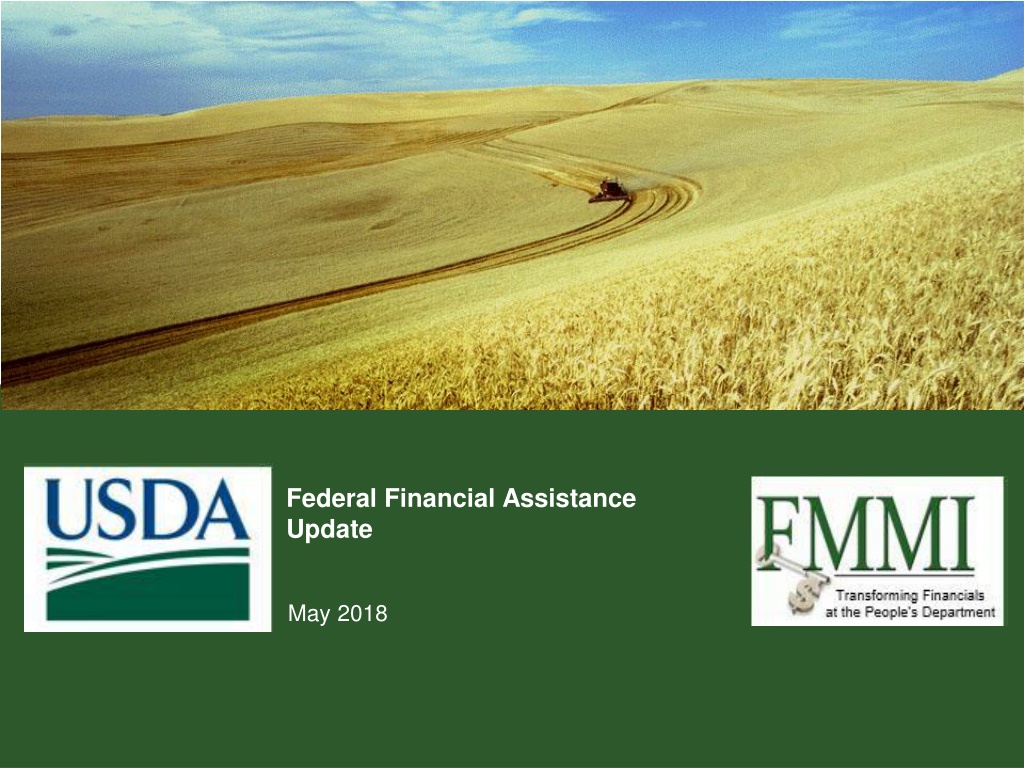
 undefined
undefined

